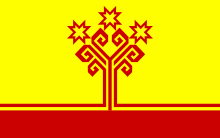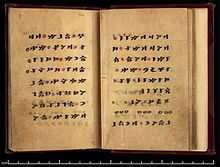Turkic mythology
Turkic mythology embraces Tengriist and Shamanist traditions as well as all cultural and social subjects being a nomad folk. Later, especially after Turkic migration some of the myths were decorated with Islamic symbols. It has many common points with Aegean and Anatolian mythologies (Greek and Hittite) as well as Mongol mythology. Turkic mythology was influenced by other local mythologies. For example, in Tatar mythology elements of Finnic and Indo-European myth co-exist. Subjects from Tatar mythology include Äbädä, Şüräle, Şekä, Pitsen, Tulpar, and Zilant. Besides Buddhism, Turkic mythology was influenced by Zoroastrianism and Manichaeism.
Irk Bitig, a 10th-century manuscript found in Dunhuang is one of the most important sources for Turkic mythology and religion. This book is written in Old Turkic alphabet like the Orkhon inscriptions.
Gods in Turkic mythology
Tengri
Tengri is one of the names for the primary chief deity in the religion of the early Turkic people. The words Tengri and Sky were synonyms. It is unknown how Tengri looks. He rules the fates of entire people and acts freely. But he is fair as he awards and punishes. The well-being of people depends on his will. Tengri worship is first attested in the Old Turkic Orkhon inscriptions of the early 8th century.
Other gods
Umay (The Turkic root umāy originally meant 'placenta, afterbirth') is the goddess of fertility and virginity. Umay resembles earth-mother goddesses found in various other world religions.
Kayra is the Spirit of God and creator god.
Ülgen is the son of Kayra and the god of goodness. The Aruğ (Arı) denotes to "good spirits" in Turkic and Altaic mythology. They are under the order of Ülgen and doing good things on earth.[1]
Erlik is the god of death and underworld.
Ay Dede is the moon god.
Gün Ana is the sun goddess.
Symbols
As a result of the nomad culture, the Horse is also one of the main figures of Turkic mythology; Turks considered the horse an extension of the individual -though generally dedicated to the male- and see that one is complete with it. This might have led to or sourced from the term "At-Beyi" (Horse-Lord).
The Dragon (Evren, also Ebren), also expressed as a Snake or Lizard, is the symbol of might and power. It is believed, especially in mountainous Central Asia, that dragons still live in the mountains of Tian Shan/Tengri Tagh and Altay. Dragons also symbolize the god Tengri (Tanrı) in ancient Turkic tradition, although dragons themselves are not worshiped as gods.
The World Tree or Tree of Life is a central symbol in Turkic mythology. According to the Altai Turks, human beings are descended from trees. According to the Yakuts, White Mother sits at the base of the Tree of Life, whose branches reach to the heavens where it is occupied by various creatures that have come to life there. The blue sky around the tree reflects the peaceful nature of the country and the red ring that surrounds all of the elements symbolizes the ancient faith of rebirth, growth and development of the Turkic peoples.
Legends
The Grey Wolf legend
The Wolf symbolizes honor and is also considered the mother of most Turkic peoples. Asena is the name of one of the ten sons who were given birth by a mythical wolf in Turkic mythology.[2][3][4][5]
The legend tells of a young boy who survived a raid on his village. A she-wolf finds the injured child and nurses him back to health. He subsequently impregnates the wolf which then gives birth to ten half-wolf, half-human boys. One of these, Ashina, becomes their leader and instaures the Ashina clan which ruled the Göktürks and other Turkic nomadic empires.[6][7] The wolf, pregnant with the boy's offspring, escaped her enemies by crossing the Western Sea to a cave near to the Qocho mountains, one of the cities of the Tocharians. The first Turks subsequently migrated to the Altai regions, where they are known as expert in ironworkers, as the Scythians are also known to have been.[8]
Ergenekon legend
The Ergenekon legend tells about a great crisis of the ancient Turks. Following a military defeat, the Turks took refuge in the legendary Ergenekon valley where they were trapped for four centuries. They were finally released when a blacksmith created a passage by melting rock, allowing the gray wolf Asena to lead them out.[9][10][11][12][13][14] A New Year's ceremony commemorates the legendary ancestral escape from Ergenekon.[15]
Oghuz legends
The legend of Oghuz Khagan is a central political mythology for Turkic peoples of Central Asia and eventually the Oghuz Turks who ruled in Anatolia and Iran. Versions of this narrative have been found in the histories of Rashid ad-Din Tabib, in an anonymous 14th-century Uyghur vertical script manuscript now in Paris, and in Abu'l Ghazi's Shajara at-Turk and have been translated into Russian and German.
Dede Korkut stories
Book of Dede Korkut from the 11th century covers twelve legendary stories of the Oghuz Turks, one of the major branches of the Turkish Peoples. It originates from the pre-Islamic period of the Turks, in which the Tengrism elements in the Turkish culture still outweighed. It consists of a prologue and twelve different stories. The legendary story which begins in Central Asia is narrated by a dramatis personae, in most cases by Dede Korkut himself.[16]
The legend of Timur
The legend of Timur (Temir) is the most ancient and well-known. Timur found a strange stone that fell from the sky (an iron ore meteorite), making the first iron sword from it. Today, the word "demir" means "iron".
Other legends
- Epic of Köroğlu
- Epic of Manas
Modern interpretations
Decorative arts

- A motif of the tree of life is featured on Turkish 5 Kuruş coins, circulated since early 2009.
- The flag of the Chuvash Republic, a federal subject of Russia, is charged with a stylized tree of life, a symbol of rebirth, with the three suns, a traditional emblem popular in Chuvash art. Deep red stands for the land, the golden yellow—for prosperity.

See also
- Alpamysh
- Asena
- Finno-Ugric mythology
- Tibetan mythology
- Scythian mythology
- Shamanism in Siberia
- Turkish folklore
Notes
- ↑ Türk Söylence Sözlüğü (Turkish Mythology Dictionary), Deniz Karakurt, (OTRS: CC BY-SA 3.0)
- ↑ Bozkurt Legend (Turkish)
- ↑ Book of Zhou, Vo. 50. (Chinese)
- ↑ History of Northern Dynasties, Vo. 99. (Chinese)
- ↑ Book of Sui, Vol. 84. (Chinese)
- ↑ Findley, Carter Vaughin. The Turks in World History. Oxford University Press, 2005. ISBN 0-19-517726-6. Page 38.
- ↑ Roxburgh, D. J. (ed.) Turks, A Journey of a Thousand Years. Royal Academy of Arts, London, 2005. Page 20.
- ↑ Christopher I. Beckwith, Empires of the Silk Road: A History of Central Eurasia from the Bronze Age to the Present, Princeton University Press, 2011, p.9
- ↑ Oriental Institute of Cultural and Social Research, Vol. 1-2, 2001, p.66
- ↑ Murat Ocak, The Turks: Early ages, 2002, pp.76
- ↑ Dursun Yıldırım, "Ergenekon Destanı", Türkler, Vol. 3, Yeni Türkiye, Ankara, 2002, ISBN 975-6782-36-6, pp. 527–43.
- ↑ İbrahim Aksu: The story of Turkish surnames: an onomastic study of Turkish family names, their origins, and related matters, Volume 1, 2006 , p.87
- ↑ H. B. Paksoy, Essays on Central Asia, 1999, p.49
- ↑ Andrew Finkle, Turkish State, Turkish Society, Routledge, 1990, p.80
- ↑ Michael Gervers, Wayne Schlepp: Religion, customary law, and nomadic technology, Joint Centre for Asia Pacific Studies, 2000, p.60
- ↑ Miyasoğlu, Mustafa (1999). Dede Korkut Kitabı.
References
- Walter Heissig, The Religions of Mongolia, Kegan Paul (2000).
- Gerald Hausman, Loretta Hausman, The Mythology of Horses: Horse Legend and Lore Throughout the Ages (2003), 37-46.
- Yves Bonnefoy, Wendy Doniger, Asian Mythologies, University Of Chicago Press (1993), 315-339.
- 满都呼, 中国阿尔泰语系诸民族神话故事(folklores of Chinese Altaic races).民族出版社, 1997. ISBN 7-105-02698-7.
- 贺灵, 新疆宗教古籍资料辑注(materials of old texts of Xinjiang religions).新疆人民出版社, May 2006. ISBN 7-228-10346-7.
- Nassen-Bayer; Stuart, Kevin (October 1992). "Mongol creation stories: man, Mongol tribes, the natural world and Mongol deities". 2 51. Asian Folklore Studies. pp. 323–334. Retrieved 2010-05-06.
- Sproul, Barbara C. (1979). Primal Myths. HarperOne HarperCollinsPublishers. ISBN 978-0-06-067501-1.
- S. G. Klyashtornyj, 'Political Background of the Old Turkic Religion' in: Oelschlägel, Nentwig, Taube (eds.), "Roter Altai, gib dein Echo!" (FS Taube), Leipzig, 2005, ISBN 978-3-86583-062-3, 260-265.
- Türk Söylence Sözlüğü (Turkish Mythology Dictionary), Deniz Karakurt, (OTRS: CC BY-SA 3.0)
External links
- Alpamysh
- Shamanism in Mongolia and Tibet
- DASTAN GENRE IN CENTRAL ASIA
- The Altaic Epic
- Tengri on Mars
- Doğan Kaya, Derlemeler
- Archive of Turkish Oral Narrative
- Turuz - Online Turkic Dictionaries
- Turklib - Turkistan Library
| ||||||||||||||
| ||||||||||||||||||||||
